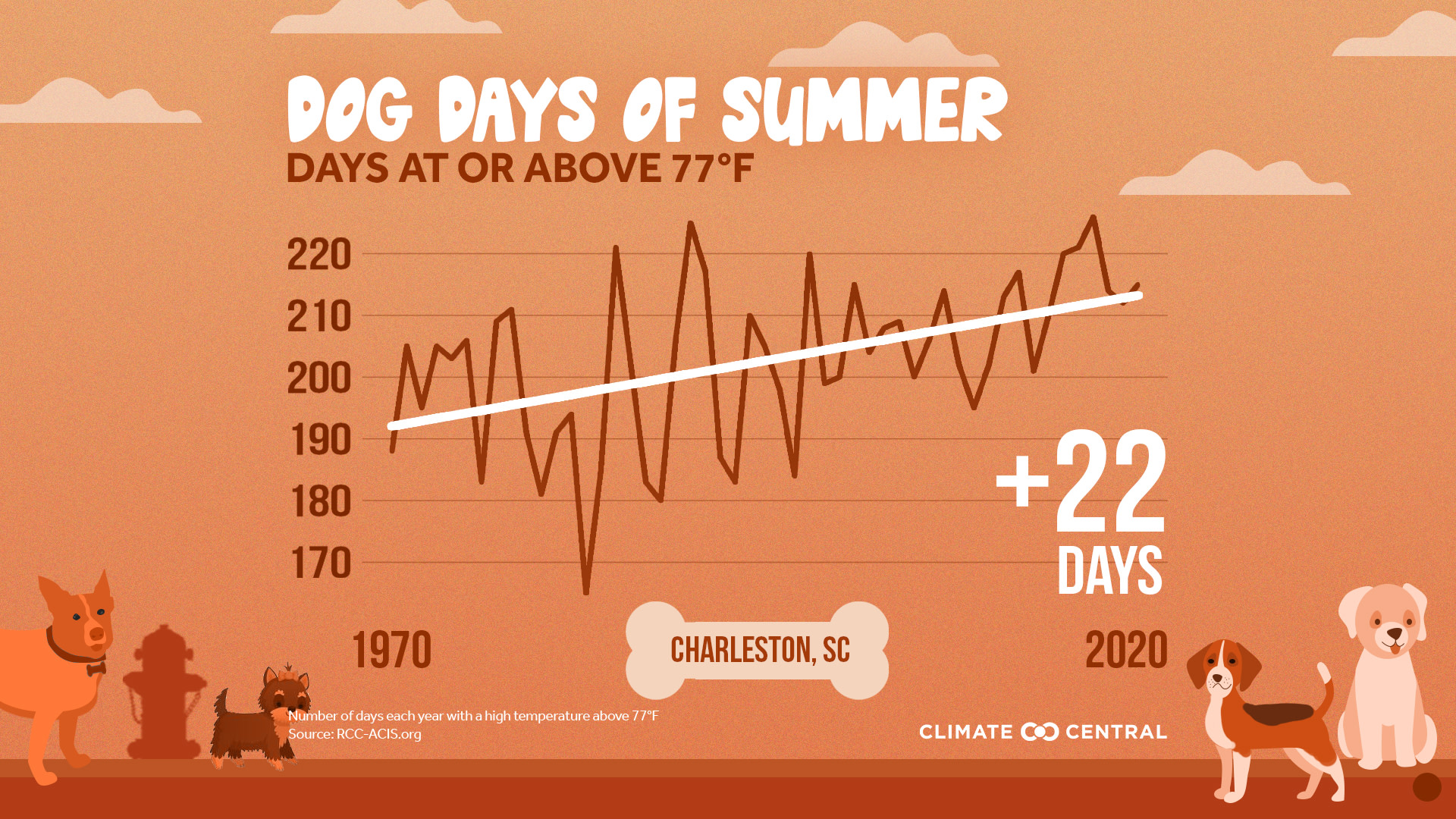KEY CONCEPTS
Climate change is making our summers longer and hotter, making for potentially dangerous conditions for dogs and cats.
When the air temperature reaches 77°F, asphalt surfaces can reach 125°F. This is the temperature that can burn human skin, and it can be dangerous for dogs’ unprotected paws.
Climate Central analyzed temperature trends for 246 U.S. cities, and found that 94% (232) have seen an increase in days that were 77°F or above since 1970.
Physical exertion or exercise in hot environments increases the risk of heat stress or heat stroke in dogs.
Where did the term dog days come from? It's when Sirius, the dog star, rises and sets about the same time as the sun. Read more from NOAA.
Warmer air temperatures mean hotter surfaces, which could mean scorched paws
When the air temperature hits 77°F degrees, asphalt surfaces can reach 125°F in direct sunlight and when there’s no wind. This is the temperature that can burn human skin, and it can be unsafe for dogs’ unprotected paws.
Climate Central looked at the temperature trends for 246 U.S. cities, and found that 94% (232) have seen an increase in days each year that were 77°F or above since 1970.
The annual number of days above 77°F has increased by at least 3 weeks on average in 43 cities.
Bluefield, Va. showed the greatest increase, with 45 more days on average above 77°F, followed by Tucson, Ariz. (40 days), Santa Maria, Calif. (34), Erie, N.Y. (33), and Flint, Mich. (31).
As air temperatures rise, pavement gets much hotter in the sunlight. At 86°F, the surface temperature jumps to 135°F. At 87°F, only one degree more, the asphalt temperature rises to 143°F. How do you know if it’s too hot for unprotected paws? Place the back of your hand on the pavement. If it’s too hot to hold it there for more than 7 seconds, find somewhere grassy or shaded to walk your dog. Or change your walk time to early morning or late in the evening when the temperature is cooler and the sun is lower in the sky.
And never, ever leave your dog in a car. Not even for a minute. On an 85°F day, a car with the windows opened slightly can reach 102°F in just 10 minutes.
It’s not just hot cars that are a threat to dogs: Heat illness and exertion
Physical activity during high temperatures increases the risk of heat stress or heat stroke in dogs. A study of veterinary records of dogs in the U.K. found that exercise triggered nearly three-quarters (74.2%) of all heat-related illnesses, compared to 5% that were due to being confined in a vehicle. Older and flat-faced dogs (brachycephalic breeds, e.g. bulldogs, shih tzus, and pugs) were at greater risk of developing heat-related illness just by sitting outside in hot weather. Other risk factors for heat stroke in dogs include:
Being a large breed dog (over 33 pounds)
Being overweight, regardless of breed
Lack of acclimation to hot or humid conditions
Lack of fitness
Additionally, some large breeds are more susceptible, including Golden and Labrador retrievers, and military or working dogs such as Belgian or German shepherds
How warmer temperatures affect dogs
Just like humans, a dog’s body temperature can be affected by ambient temperatures from the environment, as well as by exercise or exertion. Dogs have minimal sweating capacity (they sweat through glands in their paws) and mostly regulate their body temperature through panting. They are also covered with insulating fur. Things to remember:
High humidity, dehydration, and poorly ventilated spaces can hinder the effectiveness of panting.
Short-nosed dogs—such as pugs, boxers, or bulldogs—expend more energy breathing and have a decreased ability to release heat through panting.
Dogs with darker coats can absorb more heat and dogs with thick coats trap more heat near their bodies
Puppies and older dogs also have a reduced capacity to maintain their proper body temperature.
Make sure your dog has access to plenty of fresh, clean water and cool, shaded areas. Other safety tips to keep your dog cool can be found here and here.
And don’t forget about the kitties...
Cats enjoy and are naturally attracted to heat and sunny spots. The average internal temperature range for cats is between 99.5 and 102.5°F. When the ambient temperature rises above that, your feline friend could be at risk for heat stroke. Be sure your cat has access to fresh, clean water and cool, shaded areas.
RESOURCES FOR POTENTIAL LOCAL STORY ANGLES
To find animal experts, contact the veterinary schools closest to you, or reach out to a state representative from the Humane Society Veterinary Medical Association. And here’s a list of animal shelter and rescue organizations by state.
LOCAL EXPERTS
The SciLine service, 500 Women Scientists or the press offices of local universities may be able to connect you with local scientists who have expertise on heat and climate change. The American Association of State Climatologists is a professional scientific organization composed of all 50 state climatologists.
NATIONAL EXPERTS
Jessica Bell, Assistant Professor, Community Practice
Washington State University, College of Veterinary Medicine
Contact: jessica.r.bell@wsu.edu
METHODOLOGY
Climate Central analyzed annual daily maximum temperatures from 1970-2020 using data from the Applied Climate Information System.
Climate Central's local analyses include 247 stations. However, for data summaries based on linear trends, only 246 stations are included due to large data gaps in Wheeling, W. Va.
The stories below are served through a new pilot program from our partners at the Solutions Journalism Network, and were not created by or with Climate Central.
